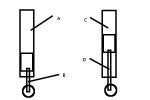Next year's up-sized Ninja 300 is replacing the current Ninja 250. With heated competition from Honda's CBR 250, the more expensive Ninja 300 will need to prove the extra expense is justified with potential buyers. Adding a bit more power is always a good selling point.
The Ninja 300 does produce more horsepower than it's predecessor, but more importantly, it produces more torque throughout the RPM range, allowing for taller gearing and less frequent shifts. The 300 has more acceleration at highway speeds than the previous model, which was always considered a weakness with the 250.
The Ninja 250's dyno numbers were virtually identical to Honda's 250 sport machine, with a difference of a mere 2-3 horsepower and a pound or so of torque. The CBR 250 is a single-cylinder and the Ninja 250 and 300 are twins. The Ninja 300 produces about 10 more horsepower and about 6 pounds of torque over the CBR 250.
![Image]()
The Ninja 300, which includes ABS, is priced at a retail of $5299. Pricing for the 2013 CBR 250 has not been released at this time, but the 2012 ABS model is priced at $4599. A non-ABS model of the CBR 250 can be had for $4099 in 2012.
[Cycle World]
The Ninja 300 does produce more horsepower than it's predecessor, but more importantly, it produces more torque throughout the RPM range, allowing for taller gearing and less frequent shifts. The 300 has more acceleration at highway speeds than the previous model, which was always considered a weakness with the 250.
The Ninja 250's dyno numbers were virtually identical to Honda's 250 sport machine, with a difference of a mere 2-3 horsepower and a pound or so of torque. The CBR 250 is a single-cylinder and the Ninja 250 and 300 are twins. The Ninja 300 produces about 10 more horsepower and about 6 pounds of torque over the CBR 250.
The Ninja 300, which includes ABS, is priced at a retail of $5299. Pricing for the 2013 CBR 250 has not been released at this time, but the 2012 ABS model is priced at $4599. A non-ABS model of the CBR 250 can be had for $4099 in 2012.
[Cycle World]





